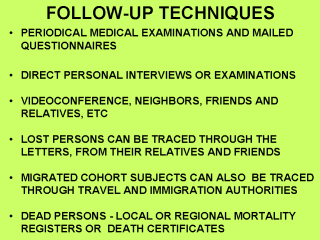| front |1 |2 |3 |4 |5 |6 |7 |8 |9 |10 |11 |12 |13 |14 |15 |16 |17 |18 |19 |20 |21 |22 |23 |24 |25 |26 |27 |28 |29 |30 |31 |32 |33 |34 |35 |36 |37 |38 |39 |40 |41 |42 |43 |44 |review |
 |
Good follow-up
increases the internal validity of the study as it minimizes attrition.
Follow-up techniques and their duration of application should be similar to both the cohorts. Cohort subjects can be followed in several ways either through direct personal interviews or examinations or indirectly through mailed questionnaires, videoconference, neighbors, friends and relatives etc. Lost persons can be traced through the letters, from their relatives and friends. Attrition should be restricted to minimum possible extent. Migrated cohort subjects can also be traced through travel and immigration authorities. Information about the dead persons regarding the cause of death can be obtained either from local or regional mortality registers or death certificates. Follow-up through the periodical medical examinations and mailed questionnaires is usually practiced. |